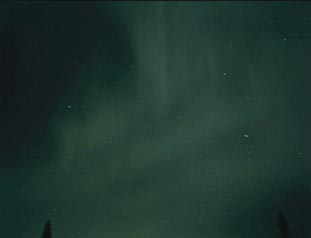|
An Auroral Mystery
On March 30, 2001, a husband and wife were camping high in
the Santa Catalina Mountains just outside Tucson, Arizona.
The night was very dark, and the only light pollution (that
is, the glow in the sky above populated areas) was in the
southern sky, towards Tucson, about 7,000 feet below.
Sometime after midnight the couple noticed that the sky to
the north had turned red. What could it be? Could the light
be coming from Phoenix, a hundred or so miles to the northwest?
But this light was red—and immense. Maybe it was a huge
forest fire…?
As they watched, parts of the red sky started to move in waves.
The couple had never seen anything like it before. One of
them suggested that it might be invaders from outer space,
which made them laugh—kind of nervously. They watched
the sky for about 40 minutes, until the movement stopped and
the mysterious red color faded away. Neither of them had a
clue as to what they'd just seen. They retired to their tent,
still wondering what it had been.
The Mystery Solved
Meanwhile, to the south, a group of people in Sabino Canyon
was watching the same phenomenon. Earlier that day they—along
with most of the other amateur and professional astronomers
in the area—had gathered at an outdoor telethon to raise
money for the Muscular Dystrophy Association. The volunteers
had set up more than 40 telescopes and a mobile observatory,
and had entertained hundreds of visitors at the daylong event.
The stragglers who were still packing up at around 10 p.m.
were mostly volunteers. They'd noticed the red glow in the
sky, too. They knew an aurora when they saw one. It was unusual
to see an aurora as far south as Tucson, but at this point
it didn't look very impressive.
But Wait…
That is, until around 11:00, when the red light started stretching
up higher and higher in the sky. Witnesses describe shafts
of white light shooting up, reaching as high as the red aurora.
By 11:30 the red glow had reached directly overhead (the zenith,
to a stargazer) and had stretched 180 degrees across the sky
from due east to due west. Now they were impressed. The volunteers
considered it a spectacular reward for
a job well done.
 |
|
|
About Auroras
What happened that night wasn't a mystery to the telethon
folks, but maybe you're still wondering about auroras. If
so, here's the lowdown: Auroras take place between 50 and
150 miles (85–250 kilometers) above the Earth and come
in many colors of the rainbow. They appear in a variety of
forms—as patches of light, or as streamers, arcs, banks,
or rays. Sometimes they even look like hanging draperies.
The aurora borealis, also known as the northern lights, are
formed when high-speed electrons and protons from the Sun
energize the radiation belts high above the Earth, then channeled
toward the northern polar regions (just like the aurora australis,
or southern lights, are channeled toward the southern polar
regions). Above the poles the electrons and protons collide
with common elements like oxygen or nitrogen: it's those millions
of tiny collisions that generate the light. The highest auroras
(up near the 250 kilometer level) are believed to be caused
by electrons and protons combining to form hydrogen atoms.
Another Mystery…
Since they're formed at the poles, it's only natural that
auroras are more visible the farther north or south you go.
Which brings up one more mystery: what was it that brought
such a spectacular light show so far south? Here's a hint—it
wasn't invaders from Mars.
Solved
The Tucson aurora was caused by an extremely powerful solar
event called a Coronal Mass Ejection (CME) that left the Sun
on Thursday, the day before its effects became visible in
Arizona. The CME had been strong enough to create northern
lights that could be seen as far south as Tucson, which is
only about 60 miles north of the Mexican border.
Thanks to the POLAR Ionospheric X-ray Imaging Experiment (PIXIE)
we can see an image of the aurora from space on March 30th.
Notice a light blue area over the southwestern United States.

PIXIE image from March 30, 2001.
(Click for
a larger image.)
If you'd like to see more auroras,
here are some places on the Internet that you can visit:
 See more aurora images from space at the PIXIE
Web site.
See more aurora images from space at the PIXIE
Web site.
 See more of Jan Curtis'
photographs at the
Home of the Northern Lights Web site.
See more of Jan Curtis'
photographs at the
Home of the Northern Lights Web site.
 Learn more
about Auroras at the Auroras
2000 Web site.
Learn more
about Auroras at the Auroras
2000 Web site.
|